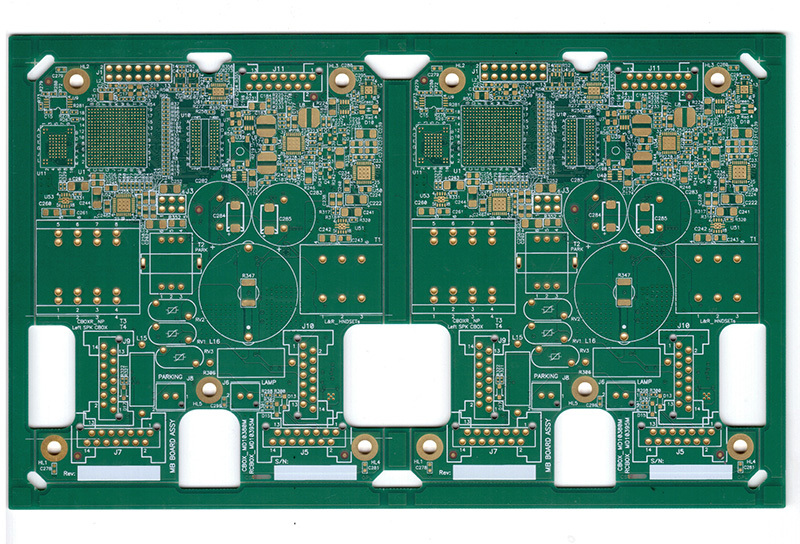Thick copper circuit board serpentine wiring should pay attention to what problems?
serpentine is a special wiring method in the wiring of thick copper circuit boards. Serpentine wiring is a common wiring method. Its main purpose is to adjust the delay to meet the requirements of system timing design; the two key parameters are parallel coupling length (LP) and coupling distance (s). So, what problems should be paid attention to in the serpentine wiring of thick copper circuit boards?

1. The distance between parallel line segments should be increased as much as possible, at least greater than 3H. H refers to the distance from the signal wiring to the reference plane. Usually, it's around the big bend. As long as the distance is large enough, the mutual coupling effect can be almost completely avoided.
2. Reduce the coupling length. When the delay of twice the coupling length approaches or exceeds the signal rise time, the crosstalk will reach saturation.
3. The signal transmission delay caused by the serpentine structure of the stripline or the buried microstrip line is smaller than that of the microstrip line.
4. For high-speed and signal lines with strict timing requirements, try not to use serpentine lines.
5. Generally, any angle of serpentine wiring can be used, which can effectively reduce the coupling between them.
6. In the design of high-speed thick copper circuit boards, the serpentine wire has no so-called filtering or anti-interference ability, which can only reduce the signal quality, so it can only be used for timing matching.
7. Carefully consider the following important questions:
(1) Do you use a small number of jumpers? Do jumpers pass through components and accessories?
(2) Can you see these letters after assembly? Is the size and model correct?
(3) In order to prevent blistering, is the large area copper foil window opened?
(4) Is there a tool positioning hole?
electronic thick copper circuit board recycling manufacturers tell us what is the classification of electronic thick copper circuit board?
electronic thick copper circuit board is mainly composed of welding board, mounting hole, wire, part, connector, electrical boundary, etc. Many people do not know the classification of electronic thick copper circuit boards, or know a little.
electronic circuit boards are divided into three categories according to the number of layers: single board, double board and multilayer electronic circuit boards.
One is single panel. In a basic PCB, the parts are concentrated on one side and the wires are concentrated on the other side. Wires are displayed on one side only.
This kind of PCB is called single-sided electronic thick copper circuit board. Single panels are usually simple to make and inexpensive, but the disadvantage is that they cannot be applied to overly complex products.
Double panel is an extension of the single panel. If single-layer wiring cannot meet the needs of electronic products, double-sided boards should be used. There are copper and rope on both sides.
passes through the circuit between the two layers through the hole to form the required network connection.
multilayer board is a printed board in which three or more conductive pattern layers are separated from the insulating material between them, and the conductive patterns are connected to each other as required. Multi-layer electronic circuit board is the product of the development of electronic information technology to high speed, multi-function, large capacity, small, thin and light.
thick copper circuit board
The circuit board factory talks about the application advantage analysis of FPC in wearable devices.
2023-07-28
The FPC mentioned by the editor of the circuit board factory has excellent performance and plays an indispensable role in electronic products, meeting the development needs of smart phones and smart wearable devices. With the trend of miniaturization and thinning of electronic products, the consumption of FPC flexible circuit boards is increasing and booming.
Multi-layer circuit board factory-multi-layer circuit board compatible design points description.
2023-07-28
Most electronic products are inseparable from the component is multilayer circuit board, and the production quality of multilayer circuit board factory directly determines the use of electronic equipment and the use of quality, there are many points in the circuit board processing related to the compatibility of multilayer circuit board, and then affect the quality of the circuit board. What are the main points of the compatibility design of multilayer circuit boards under the popular science?_multilayer circuit board_multilayer circuit board factory_blind buried hole circuit board_HDI board proofing
2023-07-28
In the graphic electroplating process method of multi-layer circuit board factory, because the circuit pattern is easy to produce side etching in the etching process, the tin-lead alloy plating part is in the air and produces a suspension layer, which is easy to fall off, resulting in a short circuit caused by bridging between wires. Multilayer circuit board factory uses infrared hot melt process method, can make the exposed copper surface get very good protection. However, when it is used for infrared thermal melting of multi-layer circuit boards, the phenomenon of delamination and foaming between layers of multi-layer circuit boards is very serious due to high temperature, resulting in a very low yield of multi-layer circuit boards. _Blind buried hole circuit board_multilayer circuit board
2023-07-28
Before designing multilayer circuit boards, the multilayer circuit board structure must be determined according to the circuit scale, circuit board size and electromagnetic compatibility (EMC) requirements. That is to decide whether to use a 4-layer, 6-layer or higher multilayer circuit board. Once the number of layers is determined, the multilayer circuit board factory has decided to determine the placement of the electrical layers in the multilayer circuit board and how to distribute different signals on these layers. This is the choice of multilayer circuit board factory laminated structure.


